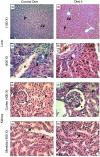Microalgae as a safe food source for animals: nutritional characteristics of the acidophilic microalga Coccomyxa onubensis
- PMID: 27756449
- PMCID: PMC5069342
- DOI: 10.3402/fnr.v60.30472
Microalgae as a safe food source for animals: nutritional characteristics of the acidophilic microalga Coccomyxa onubensis
Abstract
Background: Edible microalgae are marine or fresh water mesophilic species. Although the harvesting of microalgae offers an abundance of opportunities to the food and pharmaceutical industries, the possibility to use extremophilic microalgae as a food source for animals is not well-documented.
Objective: We studied the effects of dietary supplementation of a powdered form of the acidophilic microalga Coccomyxa onubensis on growth and health parameters of laboratory rats.
Method: Four randomly organized groups of rats (n=6) were fed a standard diet (Diet 1, control) or with a diet in which 0.4% (Diet 2), 1.25% (Diet 3), or 6.25% (Diet 4) (w/w) of the standard diet weight was substituted with dried microalgae powder, respectively. The four groups of animals were provided ad libitum access to feed for 45 days.
Results: C. onubensis biomass is rich in protein (44.60% of dry weight) and dietary fiber (15.73%), and has a moderate carbohydrate content (24.8%) and a low lipid content (5.4%) in which polyunsaturated fatty acids represent 65% of the total fatty acid. Nucleic acids are present at 4.8%. No significant difference was found in growth rates or feed efficiency ratios of the four groups of rats. Histological studies of liver and kidney tissue revealed healthy organs in control and C. onubensis-fed animals, while plasma hematological and biochemical parameters were within healthy ranges for all animals. Furthermore, animals fed a microalgae-enriched diet exhibited a statistically significant decrease in both blood cholesterol and triglyceride levels. The blood triglyceride content and very low density lipoprotein-cholesterol levels decreased by about 50% in rats fed Diet 4.
Conclusions: These data suggest that C. onubensis may be useful as a food supplement for laboratory animals and may also serve as a nutraceutical in functional foods. In addition, microalgae powder-supplemented diets exerted a significant hypocholesterolemic and hypotriglyceridemic effect in animals.
Keywords: Coccomyxa onubensis; hypolipidemic induction; nutraceuticals; rats; safe food.
Conflict of interest statement
and funding The authors declare no conflict of interest.
Figures



Similar articles
-
Ultrasound-Based Recovery of Anti-Inflammatory and Antimicrobial Extracts of the Acidophilic Microalga Coccomyxa onubensis.Mar Drugs. 2023 Aug 27;21(9):471. doi: 10.3390/md21090471. Mar Drugs. 2023. PMID: 37755084 Free PMC article.
-
Methodological Optimization of Supercritical Fluid Extraction of Valuable Bioactive Compounds from the Acidophilic Microalga Coccomyxa onubensis.Antioxidants (Basel). 2022 Jun 25;11(7):1248. doi: 10.3390/antiox11071248. Antioxidants (Basel). 2022. PMID: 35883739 Free PMC article.
-
Production of lutein, and polyunsaturated fatty acids by the acidophilic eukaryotic microalga Coccomyxa onubensis under abiotic stress by salt or ultraviolet light.J Biosci Bioeng. 2018 Jun;125(6):669-675. doi: 10.1016/j.jbiosc.2017.12.025. Epub 2018 Jan 20. J Biosci Bioeng. 2018. PMID: 29370982
-
Enhanced production of a lutein-rich acidic environment microalga.J Appl Microbiol. 2014 Apr;116(4):839-50. doi: 10.1111/jam.12428. Epub 2014 Jan 16. J Appl Microbiol. 2014. PMID: 24372827
-
Fe (III)-Mediated Antioxidant Response of the Acidotolerant Microalga Coccomyxa onubensis.Antioxidants (Basel). 2023 Mar 1;12(3):610. doi: 10.3390/antiox12030610. Antioxidants (Basel). 2023. PMID: 36978855 Free PMC article.
Cited by
-
Nutritional Value of Microalgae and Cyanobacteria Produced with Batch and Continuous Cultivation: Potential Use as Feed Material in Poultry Nutrition.Animals (Basel). 2023 Nov 6;13(21):3431. doi: 10.3390/ani13213431. Animals (Basel). 2023. PMID: 37958186 Free PMC article.
-
Blue Light Enhances the Antioxidant, Antimicrobial, and Antitumor Potential of the Green Microalgae Coelastrella sp. BGV.Plants (Basel). 2024 Nov 23;13(23):3295. doi: 10.3390/plants13233295. Plants (Basel). 2024. PMID: 39683088 Free PMC article.
-
Microalgal-based feed: promising alternative feedstocks for livestock and poultry production.J Anim Sci Biotechnol. 2021 Jun 17;12(1):76. doi: 10.1186/s40104-021-00593-z. J Anim Sci Biotechnol. 2021. PMID: 34134776 Free PMC article. Review.
-
Ultrasound-Based Recovery of Anti-Inflammatory and Antimicrobial Extracts of the Acidophilic Microalga Coccomyxa onubensis.Mar Drugs. 2023 Aug 27;21(9):471. doi: 10.3390/md21090471. Mar Drugs. 2023. PMID: 37755084 Free PMC article.
-
Methodological Optimization of Supercritical Fluid Extraction of Valuable Bioactive Compounds from the Acidophilic Microalga Coccomyxa onubensis.Antioxidants (Basel). 2022 Jun 25;11(7):1248. doi: 10.3390/antiox11071248. Antioxidants (Basel). 2022. PMID: 35883739 Free PMC article.
References
-
- Forján E, Navarro F, Cuaresma M, Vaquero I, Ruiz-Domínguez MC, Gojkovic Z, et al. Microalgae: fast-growth sustainable green factories. Crit Rev Environ Sci Technol. 2015;45:1705–55.
-
- Kay RA. Microalgae as food and supplement. Crit Rev Food Sci Nutr. 1991;30:555–73. - PubMed
-
- Gantar M, Svircev Z. Microalgae and cyanobacteria: food for thought. J Phycol. 2008;44:60–8. - PubMed
-
- Bishop WM, Zubeck HM. Evaluation of microalgae for use as nutraceuticals and nutritional supplements. J Nutr Food Sci. 2012;2:147–52.
LinkOut - more resources
Full Text Sources
Other Literature Sources

